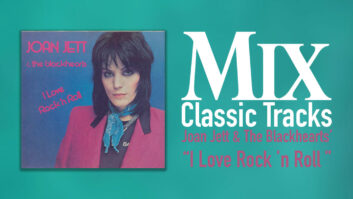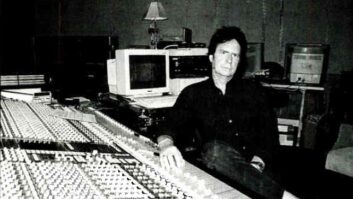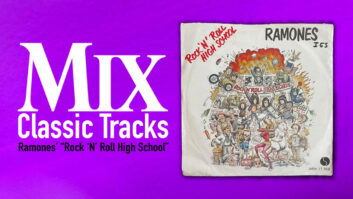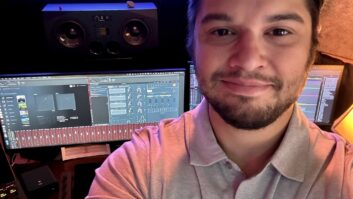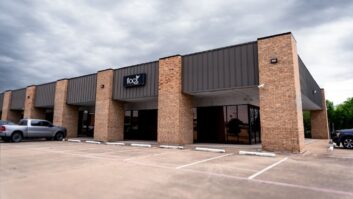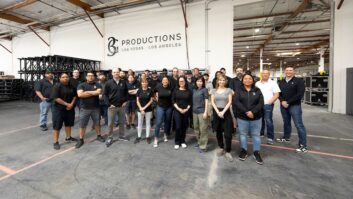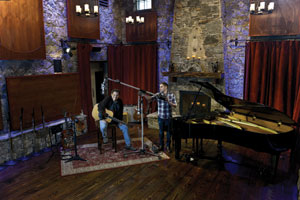
Owner/producer Billy Crockett (L) and chief engineer Charlie Kramsky in Blue Rock’s “Garrison” tracking room.
Photo: Rodney Bursiel Photography
As Texas’ music mecca, Austin has developed a healthy recording scene to service the ever-growing number of acts who have grown up there or, just as likely, migrated there from all over. (Few cities have a calling card as compelling as South By Southwest—SXSW—which started in 1987.) There are studios of every size and for every budget dotting the metropolitan area, and one of the coolest and most beautiful recording spots is found about half an hour southwest of downtown, in the scenic Hill Country, in the small town of Wimberley (pop. 2,600)—Blue Rock Artist Ranch and Studio.
Now in its eighth year, Blue Rock was built from scratch by musician, songwriter and producer Billy Crockett (yes, he’s a distant relation of Davy Crockett, of Alamo fame). And speaking of the Alamo, Crockett says that the look of the sprawling Blue Rock compound was inspired by his own love of Texas history.
“This land was so inspirational,” he says. “We used 19th century architectural elements and studied court documents of old churches and old garrisons—back when Texas was a republic [1836-46]—and used them as a guide in building it. We have this mythology that there is a garrison where the officers slept, and there is a corral out front where they would water their animals, and a lookout tower. There are acres of trails, and we used all native materials and hand-gathered stones for the building of it. We let the stone and wood be our guide, so it looks like it grew out of the ground here.” Austin’s Lou Kimball was the architect, while the central acoustic consultant and studio builder was Nashville-based Michael Cronin.
The studio’s main tracking room—The Garrison—is built completely out of stone and wood, from floor to vaulted ceiling, with large, custom-made, movable acoustic panels on the walls, “so if you want to, say, track solo piano and have the character of the room be an active participant in the sound, you can do that. Or, if you want to really tame it so you can control two or three acoustic instruments in the same space, you can do that, too,” says Crockett, who got his audio education at the University of Miami, toured for decades as a working musician, and did production and A&R in Nashville for several years. “The panels have a fiber board and cloth side, and they have a hard walnut side, so when the walnut side is facing out, they become a bass trap from the back and very reflective from the surface. We can turn them any direction, and we can also take them all the way down and pull the drapes out. The room is quite tunable.”
The Texas Room is actually bigger—it’s 24x31x22—and is used for the studio’s popular long-running live concert series, which has featured such artists as Joe Ely, Sarah Jarosz, Bill Frisell and Carrie Rodriguez, Jesse Winchester, Butch Hancock, Shawn Colvin, Iris Dement, Christopher Cross, Kelly Willis and many more regional performers, playing before a small audience. A brand-new addition to the studio’s multimedia portfolio is the 30-minute Blue Rock Live sessions webcast series. “We videotape almost everything now,” Crockett notes. “We have a video crew and HD cameras, and we’re all trying to invent ways to keep the integrity of the music but also get the fans involved more.”
At the heart of Blue Rock’s control room is a new Neve 5088 console. Comments Blue Rock’s chief engineer, Charlie Kramsky, “Rupert Neve lives just down the road from us, so we’re really close to the Neve people. They’re really great to work with, especially when we were putting the console together, because they did a bunch of mods for us.” Kramsky grew up in Dallas, studied engineering at Texas State University in San Marcos (close to Wimberley), and was an intern at Blue Rock before departing for four years in New York, where he learned the ropes at Avatar Studios. In fact, one of his first major lead engineering projects at Avatar was Bobby McFerrin’s spirityouall, which won a Grammy this year for arranger Gil Goldstein.
“Everything I learned at Avatar works here,” Kramsky says. “The studio itself is just really well-built, the rooms sound so good, and everything in here—the mics, the gear—is fantastic. And there’s a lot of variety to the work and who comes in here.”
The appeal for some acts is that Blue Rock can serve as a comfortable residential studio for out-of-area artists, with a separate three-bedroom “Band House” and smaller “Producer’s House.” As Crockett says, “We’re set up for full-tilt hospitality, with lodging and a full studio staff. I tried to dream big about a place where artists could come and go deep, deep, deep into what they love, and get a chance to turn off the world and immerse themselves in the thing that they’re here to do.”
